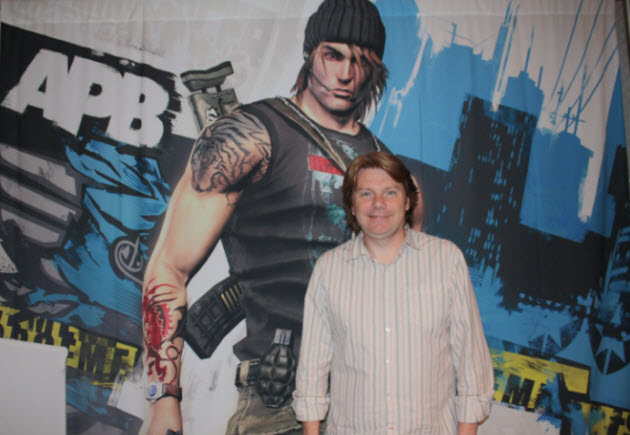You can thank David Jones for all of the mayhem in video games. He is the father of the Grand Theft Auto series of video games that first debuted in 1997 and inspired the crime genre. That ultraviolent crime game series went on to generate billions of dollars in revenue. But Jones traded that world for another one. He founded Realtime Worlds in 2002, where he became creative director. The company launched Crackdown, a comic-style urban crowd control game, and for the past five years, his company has toiled on a massively multiplayer online game, All Points Bulletin. The game shipped yesterday.
In All Points Bulletin, gamers play criminals who have to fight each other and carry out missions ranging from contract killings to heists. It’s sort of like Grand Theft Auto goes online. Jones’ company managed to produce it by raising more than $50 million in venture funding. Jones is about to find out whether his huge bet will pay off. I interviewed him at the recent E3 video game trade show. Here’s a transcript of our conversation.
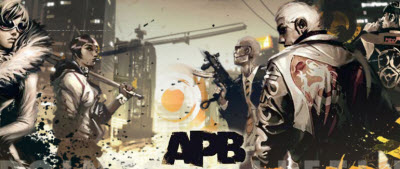 VB: How long have you been working on APB?
VB: How long have you been working on APB?
DJ: Five years. It’s been a long time. We had technology challenges.
VB: Did you start right after shipping Crackdown?
DJ: We had a small team working on it. We were doing prototypes. Tossing around ideas. When Crackdown ended, we went full-bore on it.
VB: What was the goal? To do Grand Theft Auto in an online way?
DJ: No. It was actually to create a great fun online game. We were frustrated with online games ourselves. The worlds that existed had no players. They were dead. We wanted to allow customization, persistence, no waiting around in game lobbies, and everything from four-player battles to 20-player battles. Online is fun. It was time to raise the bar.
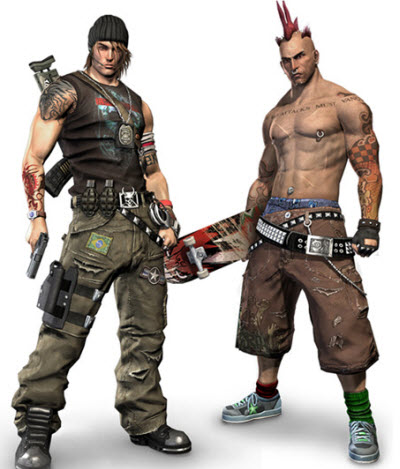 VB: Can you describe your technology evolution?
VB: Can you describe your technology evolution?
DJ: We are really happy with the fact that even with hundreds of thousands of players, everyone can play in real time. To be able to transmit communications in real time — each one with unique vehicles, weapons and music — that’s hard. You can have 100,000 players with all that. One question is how many players to put in a city. We settled on 100. If you have 100 players with full physics and thousands of artificial intelligence characters as well — running at 60 frames per second — that takes a lot of networking technology. You have to keep it synchronized.
VB: The idea of shards (dividing online games into sections) is still alive in this game?
DJ: Yes. The shards are done in a way that is a huge benefit to the players. A lot of online games aren’t flexible. You have 3,000 to 5,000 players on a server. That is typical. You have to create a game for 3,000 to 5,000 players and keep them all happy. We have the benefit of a lot of players, with 100,000 or more players per world. But we have 100 player shards. If we wanted to, we could change the rules in every one of the shards. Then we are catering to just 100 people. We have launched APB as the core game with its own rules. If you want to set up your own rules, you will be able to.
VB: So you can set up your own ‘hoods?
DJ: Exactly. We have upgradeable weapons in the game. You can add attachments to your weapons. In the beta test, we had people wondering if a team won because they had better weapons or better skills. Some people said it would be better without weapon upgrades. But I like the fact that you can have a progression and upgrade your weapons. I said what we will do is introduce a rule set where the weapon upgrades don’t make a difference. We dynamically load the instances of each shard, based on demand. We don’t care what rules they have.
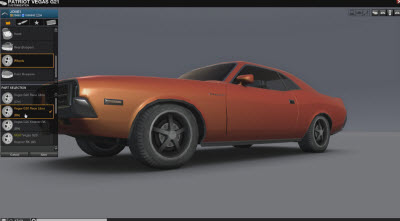 VB: How do the best players play? I just played it and charged to the blue square, where the objective of the shard was, and got shot.
VB: How do the best players play? I just played it and charged to the blue square, where the objective of the shard was, and got shot.
DJ: What we have right now is a deeply tactical game. If you have a team of four people who know how the weapons work, then they can organize. If you are storming into a building, the criminals will probably be there laying in wait. Don’t go through the front door all at once. It’s all the basics. The really good players operate as a SWAT team operates. They are very efficient. But you don’t have to play those players because of our matchmaking system. We have a Threat rating and we know who the really good players are. Every time they play, we collect their stats. If four players are really good, we would not pit them against four new players. We may pit them against 20 new players. That evens out the odds.
VB: How many missions do you have?
DJ: We have 20 or 30 mission types. Our missions are dynamic in the placement of everything. If you have to go and break into a building, the building location can change. We dynamically decide the routes, locations and where you need to be. The same mission can play out in a different way based on where you are. Most importantly, you have no idea what the opposition will be because they are always real players.
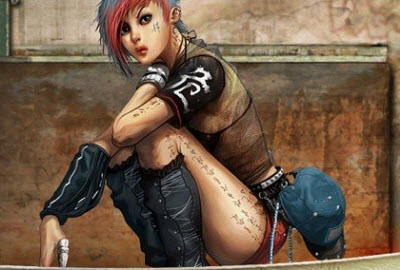 VB: What kind of ladder is there for players to advance?
VB: What kind of ladder is there for players to advance?
DJ: There is the player rating. That can go up to nearly 300. It opens more equipment to you and customization. Then we have all of the leagues. We have player or clan-based leagues. We have daily, weekly or monthly leagues. All with nice rewards at the end of them. We have more than 100 achievements in the game. Many kinds of ladders are in the game.
VB: You started this company like a Silicon Valley startup. You raised money and went a very different route from most game studios. Why?
DJ: As you know, the gaming market is a hard one with as many failures as successes. Especially in single player games. Online is different. The launch is just the start. It’s more like a service. You convince people to pay for it. It’s harder to do. If you have a good online team, you can raise money from investors.
VB: Was it hard to hold this together for more than five years? You raised money multiple times.
DJ: It turned out to be a lot like a traditional publisher arrangement. Your project gets delayed, you go back to the publisher to get more money. Then you give up some of your royalty rate when you get more money. The same thing happens with the VC route. We play with the ownership of the company when we get more money. The difference is that with the VC money, you are more independent. You can cut a deal with a publisher at any point along the way. You can do it when the time is right.
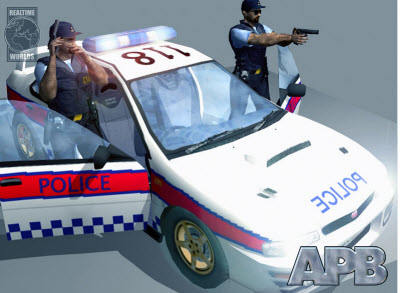 VB: You brought aboard EA as your publisher late in the game.
VB: You brought aboard EA as your publisher late in the game.
DJ: Yes, we did. It was late in the game and that was fine. EA Partners could see the product that was nearly finished. The publisher did not have a lot of input into the project because it was nearly done. It was exactly the right kind of deal for us.
VB: How many people are working on it?
DJ: WE have 120 developers, about 70 testers, and about 30 people will operate the game.
VB: Do you have other teams in motion now?
DJ: We will effectively split the team, with some people working on fixing bugs. Others will handle the first content updates, which are very important. They are working on different areas at once.
VB: You are not trying to do what Trion Worlds is doing with three different teams working on MMOs at the same time?
DJ: No, there are some wise heads on shoulders in our company. We don’t want to spread ourselves thin.
VB: What feedback have you gotten?
DJ: Really good. We closed the beta three weeks ago. I have to say it was an emotional experience. Some people were playing eight or nine months. We had 3,000 to 4,000 that played for the entire period. It was one of the high points of my life and quite emotional. I felt like we killed 5,000 characters. We asked people to send us what they had created. It was online parties on the street. It was a tremendous ending. They parked their cars and lined up for a memorable screen shot. I have never worked with so many players before in making a game. They had in-game tattoos.
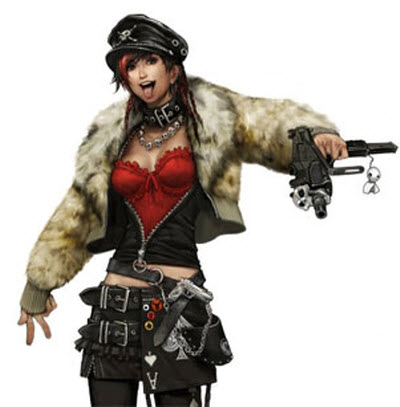 VB: Are you hooked on making MMOs now?
VB: Are you hooked on making MMOs now?
DJ: I believe online is where our industry is going. You give the players tools and you’re amazed at what they create. I just miss that when I go back to a pre-defined single player world. When I log into the world, it’s different every day. I see things that make me laugh or cry with frustration. It would be hard to go back. Most games have strong connectivity these days, but there is so much more we can do.
VB: Do you have defined metrics for success here?
DJ: No. We are going to launch. The launch is a beginning. We know we have to build this game. I think this will grow virally as friends bring others into the game. We have to deliver something that is good and grows.
VB: If you stuck to doing a game in two or three years and published this earlier, what would be different? The VCs seem to have moved on into the social gaming space.
DJ: I think the social craze is helping us. People know they want to be connected. It reinforces the fact that online works. People want a better quality of game online. More players want dedicated servers in a game that they can call their own. That plays to our strengths.
VB: When you worked on the game, were there some major turning points?
DJ: We worried we would not get to this point. We focused on the 100 players in the same space. That was a difficult goal. We thought it would resonate with players. We made a lot of game design changes. For a while, we had lock on combat, where you stay fixed on one player that you are fighting. That made it feel too much like a role-playing game. Then we had to overcome latency (delay) issues. We needed to deliver fast connection times.
VB: Is there much direct competition?
DJ: Not in terms of creativity. In terms of third-person mission games, not really. People compare us to first-person shooters.
VB: There is another Crackdown game coming from Microsoft. That’s competition this time.
DJ: That’s not direct competition. We have a hosted game with a unique combat system and creativity. There is not a lot else out there now.
VentureBeat's mission is to be a digital town square for technical decision-makers to gain knowledge about transformative enterprise technology and transact. Learn More
